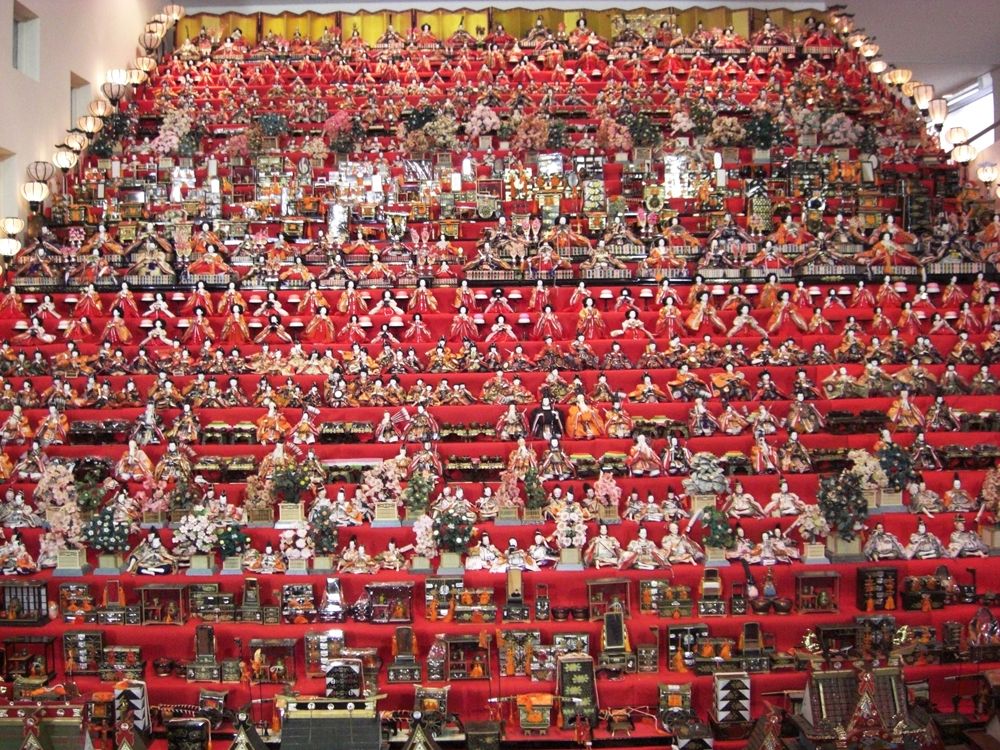
Today is Doll’s Day in Japan, and the stores are full of amazake (sweet sake) and sweets called arare, traditional fare which are consumed along with chirashizushi (fish on a bed of rice etc) in front of the display of family dolls. Some shrines hold events to celebrate the occasion, and Tomisaki Shrine in Katsuura, Chiba Prefecture is particularly worth a visit, as the article below from Japan Today makes clear (photo above from the same source).
*******************************************************
Origins (from Wikipedia)
The custom of displaying dolls began during the Heian period. Formerly, people believed the dolls possessed the power to contain bad spirits. Hinamatsuri traces its origins to an ancient Japanese custom called hina-nagashi lit. “doll floating”), in which straw hina dolls are set afloat on a boat and sent down a river to the sea, supposedly taking troubles or bad spirits with them. The Shimogamo Shrine (part of the Kamo Shrine complex in Kyoto) celebrates the Nagashibina by floating these dolls between the Takano and Kamo Rivers to pray for the safety of children. People have stopped doing this now because of fishermen catching the dolls in their nets. They now send them out to sea, and when the spectators are gone they take the boats out of the water and bring them back to the temple and burn them.
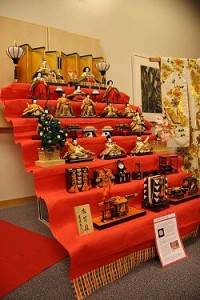
7-tier hina doll set (Wikicommons)
The customary drink for the festival is shirozake, a sake made from fermented rice. A colored hina-arare, bite-sized crackers flavored with sugar or soy sauce depending on the region, and hishimochi, a diamond-shaped colored rice cake, are served. Chirashizushi (sushi rice flavored with sugar, vinegar, topped with raw fish and a variety of ingredients) is often eaten. A salt-based soup called ushiojiru containing clams still in the shell is also served. Clam shells in food are deemed the symbol of a united and peaceful couple, because a pair of clam shells fits perfectly, and no pair but the original pair can do so.
Families generally start to display the dolls in February and take them down immediately after the festival. Superstition says that leaving the dolls past March 4 will result in a late marriage for the daughter.
*********************************************************
Playing with dolls: Explore the traditional trappings of Hina dolls
By Vicki L Beyer Japan Today March 1, 2013
Traditionally in Japan the third day of the third month was celebrated as girls’ day and the fifth day of the fifth month was celebrated as boys’ day. When the decision was made to create a Children’s Day national holiday after World War II, the date of boys’ day was selected. But that doesn’t stop people from observing the girls’ day holiday with its traditional trappings, most notably the Hina dolls. In fact, an alternative name for the girls’ day holiday is Hina Matsuri, or doll festival.
There are a number of theories as to the festival’s origins and the display of dolls representing an emperor and empress and their courtiers is believed to have begun early in the Edo Period (1603-1867). Over the years, the doll sets have become increasingly elaborate, with the grandest collections consisting of an emperor and empress, ladies-in-waiting, other courtiers, musicians with their instruments, dancers and various furnishings, including lamps, chests, food boxes and sometimes even a palanquin. The dolls, usually in Heian Period (794-1195) dress, are arranged on a red felt covered stair-step dais, with the imperial couple at the top and then the courtiers by descending rank.
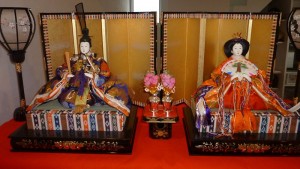
Emperor and Empress set (Wikicommons)
Part of the tradition is that when a baby girl is born into a family, she is given a set of Hina dolls that are put on display in the family home each year during the festival, usually beginning in the middle of February. In modern Japan, where storage space is limited, some stores that sell Hina dolls offer a special storage package with the sale.
The culmination of the festival is its last day, March 3, when diamond-shaped rice cakes (“hishi-mochi”), a rice malt and sake drink (“shirozake”), and sugar-coated puffed rice (“hina arare”) are consumed.
As one would expect of a festival for girls that is centuries old, the point of the festivities is to instill femininity in young girls. Even the colors of the festival, white, pink, and pastel green, symbolize various feminine virtues.
It is believed that if the dolls are not put away promptly after the festival’s end, it will delay the girl’s marriage. (I never put mine away and got married when I was 30, so it would seem it doesn’t cause too much of a delay.)
In keeping with the marriage theme, one of the popular games of the festival is a form of Concentration that involves matching the paintings inside pairs of clam shells. Since only an original pair of clam shells will fit together properly, such a pair symbolizes the perfect match of marriage.
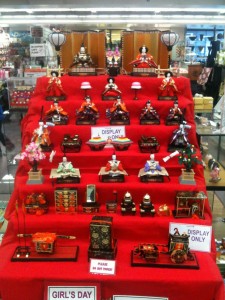
Display of dolls with accompanying items such as drawers, furniture and carriage (Wikicommons)
While the festival was originally a family celebration, it became a popular grade school activity in the latter half of the 20th century. Recently, the symbols and decorations of the festival have joined the ranks of seasonal decorations in train stations, hotel lobbies, department stores, and other commercial establishments. They’ve even become popular displays at this time of year in Japanese parks and gardens around the world.
In addition to these seemingly ubiquitous Hina doll images, in this season there are a number of formal (and sometimes extensive) collections of Hina dolls featured in special exhibitions. Below are three particularly fine displays to consider visiting. They may even provide an excuse for a weekend getaway.
Tomisaki Shrine (Katsuura, Chiba; through March 3): Chiba’s Katsuura takes its observance of the Hina Matsuri seriously, with several large displays of dolls in various locations around the city. The observance is also traditional, insofar as the dolls are put away immediately after girls’ day. One of the most spectacular displays in Katsuura is at hilltop Tomisaki Shrine, where 60 steps leading to the shrine are covered with red carpet on which more than 1,200 dolls are displayed. Although the size of the display makes it difficult to examine the dolls very closely, it’s still a very impressive collection in a very impressive setting. The display is especially dramatic after dark, when it is specially illuminated.
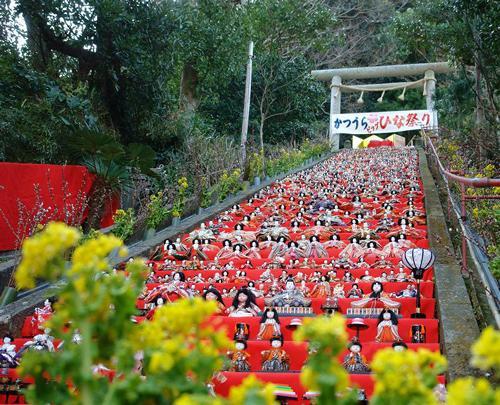
Tomisaki Shrine display (from Japan Attractions website)

Leave a Reply